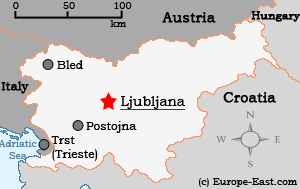Official name
Republika Slovenija (Republic of Slovenia). In Austria and Germany, the country is known as 'Slowenien'. The name derives from the word Slav - most inhabitants of the country are ethnic South Slavs. Before declaring independence, Slovenia was called 'Federal Republic of Slovenia'.
Area & Population

| ||
| Clickable Map of Slovenia |
Slovenia covers an area of 20,273 km². (equal to the size of Wales or New Jersey). Slovenia is the smallest of the countries developing from Ex-Yugoslavia.
The population is 2.015 million * (2004). The trend is negative - the netto growth rate has sunk below zero.
Ethnic groups in Slovenia are as followed: Slovenes 93%, Serbs 2%, Croats 1.8%, Bosnians 1.1% and many others - eg Italian, Hungarian, Roma etc. minorities (as of 2001). This means, that the Slovenian population is far more homogeneous than the population of other Ex-Yugoslav countries.
Religion
57.8% are Roman-Catholic, 2.4% Muslims, 2.3% Serbian-Orthodox and others, incl. atheists. (2002). *.
Time zone
As in middle Europe: GMT +01 hr, with daylight-saving time (+1 hour) in summer.
*Source: CIA World Factbook
Slovenščina (Slovenian, also called Slovene) is the offical language. In Austria, the language is sometimes also referred to as Windisch (Vindic). The relation to the dead language 'Wendisch', once spoken by a minority in Central Germany, is quite obvious. The Slovenian language has always been treated as an independent language, in contradiction to →Serbian and →Croatia, which was once, despite many differences, treated as one language called Serbo-Croatian. Slovenia, as well as Croatian, Serbian etc, belongs to the South Slavic language group. Centuries ago, Slovenian was heavily influenced by the German tongue. However, Slovenian was widely reformed during the 20th century. As a result, many German words were abolished and the language became 'more Slavic' again. Same as Russian, Slovenia has six different cases (German: 4, English: none). And it has a rare, distinctive feature: There's not just the singular and plural, but also the so-called dual form.
Slovenian uses Latin script and additionally some diacritic characters, but in contradiction to Croatian, there are only three diacritic characters, as there are:
- Č ( č ), read as the [ ch ] in [ change ].
- Š ( š ), read as the [ sh ] in [ share ].
- Ž ( ž ), read as a voiced [ sh ], close to the [ s ] in [ casual ].
Many words are closely related to Serbian and Croatian, so you won't notice a big difference when you enter Slovenia from Croatia. This is of course limited to the first, superficial sight. Many, mostly young people speak English fairly well. But German and partially Italian are spoken, too.
©2024 Europe-East.com

 Albania
Albania Slovenia
Slovenia